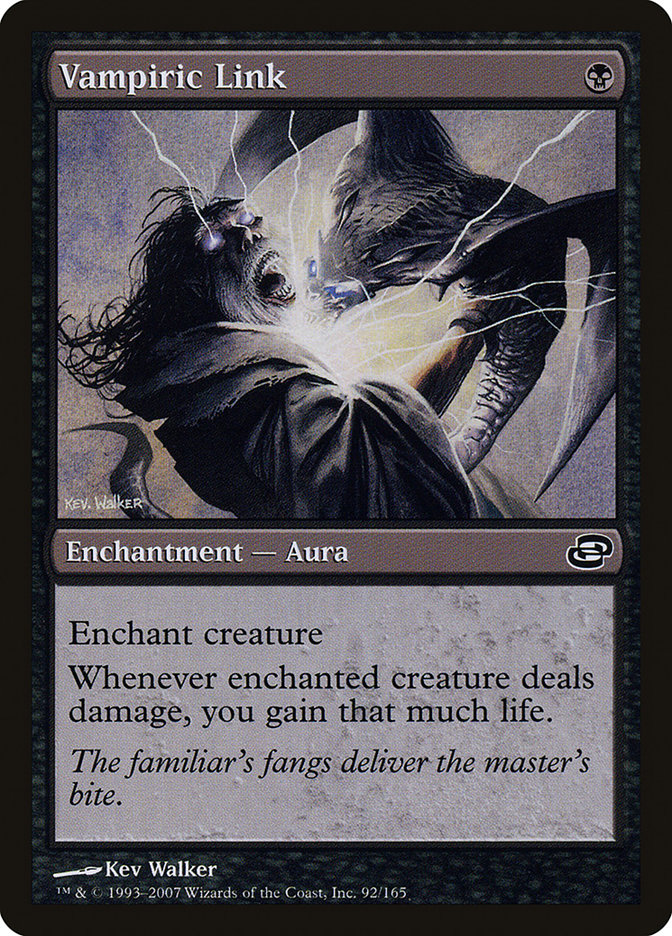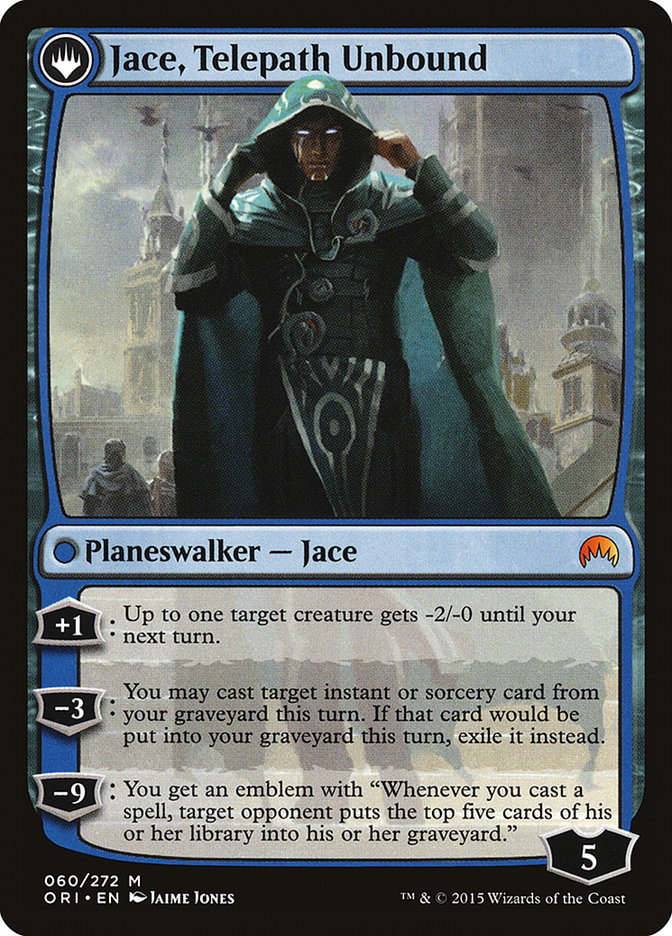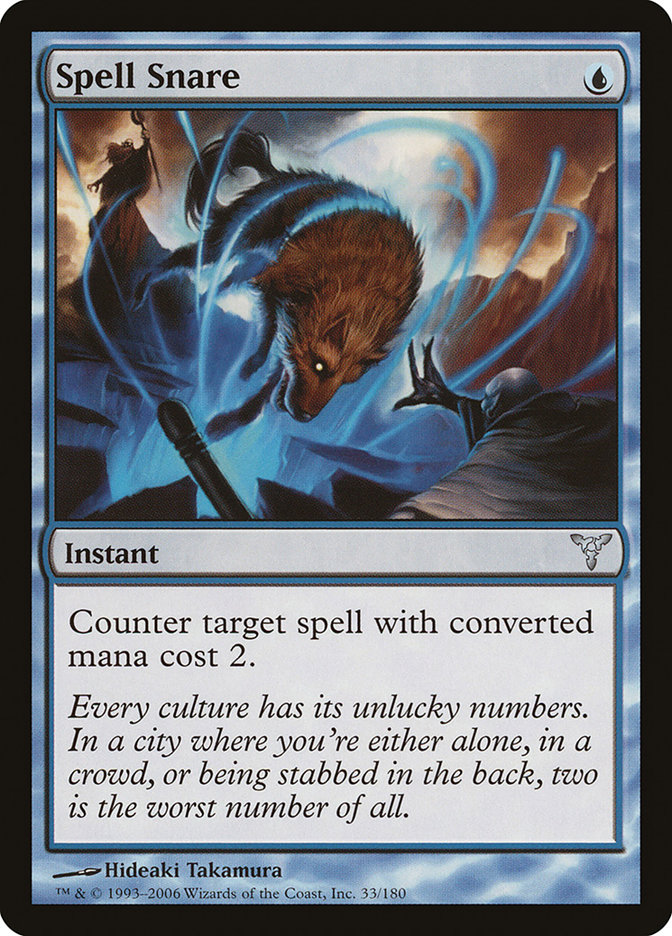
Let’s just cut to the chase…
Jace Vryn’s Prodigy is not only more than capable of competing in Modern, but will soon see play in every format. Over the next few years I suspect he may prove to be one of the best two-drops ever printed. Here’s the list that I made the Top Eight of the Open Series in Charlotte with:
Creatures (10)
Planeswalkers (2)
Lands (23)
Spells (25)
- 4 Lightning Bolt
- 4 Serum Visions
- 3 Terminate
- 3 Remand
- 2 Spell Snare
- 4 Inquisition of Kozilek
- 2 Thought Scour
- 3 Kolaghan's Command
Sideboard

While I had access to a ton of resources in regards to how to construct a Grixis deck due to their popularity online and the various flavors that currently inhabit Modern, applying those shells to my deck which would be heavily reliant on Jace, Vryn’s Prodigy was tricky to say the least. I started last week with a list that looked far more reminiscent of Jund down to the land count, but as the Open approached I ultimately decided to lean back towards classic Modern blue decks with twenty-three lands and the velocity of Remand and Thought Scour. It’s worth noting that before the tournament, I wanted to try a copy of Rise // Fall over the third Kolaghan’s Command, but it simply didn’t exist in the room. Frankly, that was fortunate. As for moving forward, I typically find that the best way to reflect upon brews is the most simple.
What I Did Right
- Playing Jace
Well, not only did I put Jace Vryn’s Prodigy into my deck, but thankfully most of my theory regarding how he would play out was correct. Leaning on discard spells like Inquisition of Kozilek not only help clear the way for Jace to actually survive, they also give him a valuable disruption tool to leverage with the Telepath Unbound’s -3 ability. Again, the major distinction between Jace’s planeswalker form and Snapcaster Mage is that the former does not play favorably with countermagic. As a result, it is imperative to play sorcery-speed disruption. That being said, I didn’t want to abandon counterspells completely. Having the versatility to still make Snapcaster Mage a powerful flash tool makes this Grixis deck difficult to play against and permits a great deal of flexibility as far as how you can use your resources now that Snapcaster Mage isn’t stressed to always have to be killing creatures.
The critical argument against Jace that he would always die proved to be both true and false. What I mean by this is that, yes, he did die quite a bit. However, this proved to nearly always be a favorable exchange. This Grixis deck makes better use of Kolaghan’s Command than any other deck I’ve seen. While everyone is well-versed in how powerful a combination Snapcaster Mage and Kolaghan’s Command are when going late, it’s not until you play with Jace in addition that you understand how much weight it can pull. The fact that I was forced into playing a third copy due to lack of card availability was fortunate, as it is Kolaghan’s Command that allows the deck to snowball incredibly quickly. What actually proved to be the most interesting aspect of the tournament for me is that the “discard a card” mode was probably the one I used the most. Frequently, I would re-buy Jace and make my opponent discard a card on their upkeep. They would be forced to fight and tie up their mana… and if I won the exchange, I could then untap into a Jace which would flip against an exhausted opponent and run wild.
Yes, Snapcaster Mage can attack and block, but Jace can flashback multiple spells. Common lines of play if I were to untap with Jace, Vryn’s Prodigy on the battlefield would look like: activate Jace and transform, + ability on an opposing creature and interact with my opponent from spells in my hand. The following turn I could -3 on a Kolaghan’s Command returning another Jace and killing a creature. On the third turn of the sequence I can then flashback another spell with Jace, finally putting him in the graveyard before flipping my new copy to keep going. Needless to say, this is hard to keep up with.
- The Manabase/Liliana of the Veil
 My mana was a dream, and one of the best aspects of the deck that I stumbled into basically on accident. By choosing to play Liliana of the Veil, and as a result model my mana after Jund decks, I took very little damage from my lands, I could almost always play my spells on curve, and I had little issue with hate cards like Choke and Blood Moon. Blackcleave Cliffs is an all-star when you want to be casting Inquisition or Lightning Bolt on turn one and the fact that it is not imperative to get double blue early or be forced into working towards casting Cryptic Command gave me a lot of flexibility in how I fetched my lands, typically allowing me to choose pain-free options.
My mana was a dream, and one of the best aspects of the deck that I stumbled into basically on accident. By choosing to play Liliana of the Veil, and as a result model my mana after Jund decks, I took very little damage from my lands, I could almost always play my spells on curve, and I had little issue with hate cards like Choke and Blood Moon. Blackcleave Cliffs is an all-star when you want to be casting Inquisition or Lightning Bolt on turn one and the fact that it is not imperative to get double blue early or be forced into working towards casting Cryptic Command gave me a lot of flexibility in how I fetched my lands, typically allowing me to choose pain-free options.
Ironically, my match loss to Burn early in the tournament likely came because of my decision to have to shock myself on turn one in order to play out my hand fully on-curve. This is just a fact of Modern, but it happened so infrequently over the course of fifteen rounds because my mana was great. Being able to play Cliffs on turn one into Inquisition and then Lightning Bolt on turn two after playing Creeping Tar Pit is incredible.
The major decision to skew my mana towards Lilliana of the Veil over Cryptic Command was a tactical decision surrounding Jace. Again, as I touched on last week, Liliana of the Veil and Jace, Vryn’s Prodigy function well together because the latter functions favorably from a low resource base. When both players are down to working with a single card or two, and it just so happens that yours are planeswalkers that have access to a stocked graveyard, you can usually weasel your way out of any predicaments you find yourself in.
What I Did Wrong
- Suboptimal Interactive Spells
Jund plays Thoughtseize. There is a critical reason that Jund plays Thoughtseize, because it needs a way to beat cards like Cryptic Command, Karn Liberated, and Primeval Titan. While I had one in my sideboard, I could have heavily benefited from having a copy or two in the maindeck. Grixis can easily tear through its deck with manipulation, and particularly when playing eight re-buy effects it’s not difficult to be able to cast a specific spell twice. I struggled a great deal against any deck playing “expensive” spells in the first game because I was so polarized towards Inquisition of Kozilek and Spell Snare.
Speaking of Spell Snare, it’s not that the card is bad, or even that it was particularly poor for me, it just doesn’t line up well on my curve. Although my choice to play Blackcleave Cliffs was great, I am not afforded much time or a lot of extra blue mana to leave up for Spell Snare often as a result of this skewing towards black mana. Playing Remand is a fine opportunity cost to pay, as it often shatters your opponent’s tempo and digs you deeper into your deck, but leaving up Spell Snare in this build of Grixis is surprisingly difficult. It is also telling that not once in the tournament was I interested in flashing back a Spell Snare with Snapcaster Mage, which is typically a common play for blue decks.
- Poor Closing Speed
Most Grixis decks, even with very few win conditions, are able to essentially close out games with the combination of Cryptic Command and Snapcaster Mage. While Jace Grixis is exceptional at grinding its opponents down to having very few resources to work with, there were a few times I had to sweat it out because my Tasigur would end up exiled thanks to the top of my opponent’s deck and couldn’t be accessed via Kolaghan’s Command. In these situations, and in many others where I had taken the early initiative, I wish I had another win condition. This likely means just a single copy of Gurmag Angler and a third Creeping Tar Pit, which was exceptional. To facilitate this change, we need a third Thought Scour. Even if I were to keep the threat base as it were, I would still ultimately probably add a third Scour as it does so much work in the midgame for finding Kolaghan’s Command or Snapcaster Mage depending on which piece you’re missing to dramatically power up the Telepath Unbound.
- The Sideboard Stinks
The problem is that I’m not really sure how to fix it. Dispel is probably the best blue sideboard card in Modern, and I was happy with all three. Jace Grixis is the best Kolaghan’s Command deck in the format and it is imperative that we win the Command wars, which Dispel does admirably. Not to mention the card is amazing against Burn, Grishoalbrand, and makes opposing Cryptic Commands look like a joke. Beyond that, it’s not clear to me. While I originally had Anger of the Gods, Gerry suggested I make the switch to Pyroclasms and they were great in a few specific matchups. Nihil Spellbomb is another excellent card in the Grixis mirrors that serves as a hedge against graveyard strategies.
Molten Rain was pivotal in the matchups I played against land decks, but even then I feel like I won by inches and got pretty lucky to do so. I’m not suggesting that we should play nothing for those decks, and Molten Rain did in fact turn out to be great with Jace, but it generally feels like a weak use of the slots.
I believe getting away from Negate was a big mistake, as it makes our Snapcaster Mages incredibly effective in a variety of matchups and it would have given me a lot more flexibility to not get so aggressive in spots where I was advantaged. I felt like I had to push the issue before that initiative waned, and Negate would in a sense give the deck that “Cryptic Command check mark” without breaking our mana’s back.
Spellskite was pretty terrible. I did play against G/W Hexproof once, but I was fortunate enough to draw my Liliana in the first game. Even against Burn, they’re shockingly well-prepared for Spellskite. Not only are they incentivized to bring in Destructive Revelry already for Dragon’s Claws, but now with Atarka’s Command the Burn decks are able to construct a sideboard configuration with a critical mass of burn spells that Spellskite can’t redirect. This, coupled with the fact that Splinter Twin probably isn’t even interested in combo’ing you out in post-sideboard scenarios and its natural weakness to Kolaghan’s Command means that I have no interest in playing the card in the future.
Putting all of this information together, I’d start with the following list:
Creatures (11)
Planeswalkers (2)
Lands (23)
Spells (24)
- 4 Lightning Bolt
- 4 Serum Visions
- 3 Terminate
- 2 Remand
- 2 Thoughtseize
- 3 Inquisition of Kozilek
- 3 Thought Scour
- 3 Kolaghan's Command
Sideboard

 With the addition of another big Delve threat in Gurmag Angler, I now feel comfortable with moving towards Vampiric Link over Dragon’s Claw. While I always felt it was more effective than Claw, we were too threat-light previously to properly utilize it. Moving towards a fourth Terminate and the additional discard in Thoughtseize certainly makes us an even better “sorcery-speed” deck, which Jace benefits from greatly. I’m not positive about the small changes in the manabase in removing an Island. I was already a little light on blue sources, and cutting the Darkslick Shores for the fourth Blackcleave Cliffs may be poor regardless of the fact that Spell Snare has been cut.
With the addition of another big Delve threat in Gurmag Angler, I now feel comfortable with moving towards Vampiric Link over Dragon’s Claw. While I always felt it was more effective than Claw, we were too threat-light previously to properly utilize it. Moving towards a fourth Terminate and the additional discard in Thoughtseize certainly makes us an even better “sorcery-speed” deck, which Jace benefits from greatly. I’m not positive about the small changes in the manabase in removing an Island. I was already a little light on blue sources, and cutting the Darkslick Shores for the fourth Blackcleave Cliffs may be poor regardless of the fact that Spell Snare has been cut.
Regardless, I hope that you try out this more unique flavor of Grixis. While I won’t be able to make it to the Open Series in Cincinnati in two weeks, perhaps some of you will just take my word for it that playing with Jace in Modern is a ton of fun and incredibly powerful.





